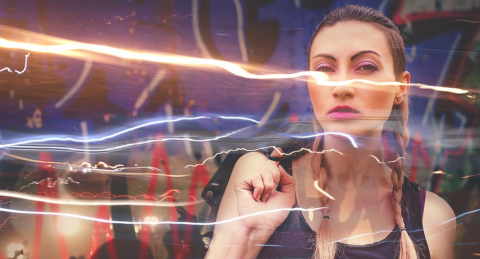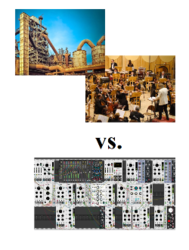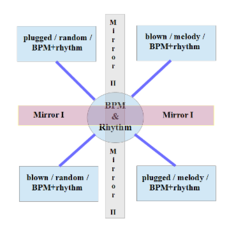Thoughts on Generative Music - Part 8

Thoughts on Generative Music - Part 8
(contains embedded video) If you want to support my work, please make use of the "PayPal" button - thank you very much indeed!
Two More Decisions to be made
There are at least two other decisions to be made in generative music:
Decision 3:
Do I allow myself to intervene from time to time?
And
Decision 4:
Do I follow a clean puristic approach, or do I allow myself to record single pieces and put them together in a later production process?

Besides pure “ideology” Decision 3 depends on the length of our piece, and on what kind of listener we are addressing. The longer the piece is, the more often it will be needed to intervene, to change the patching, if we want to keep the attention of an active listener, of a listener, who really wants to notice, to understand, and savour the details of our music, whereas the listener, who rather likes relaxing with a bit of sonic goings on in the background, who doesn´t want to get distracted from their own thoughts and flowing feelings or meditations won´t mind, when the piece doesn´t really develop and doesn´t deliver peaks of sensation over a quite long time.
Decision 4 is mere ideology – and not really dependent on whether we are performing life or producing the piece in our studio, because even in life situations we can insert pre-recorded parts and samples.
Some Words about Basic Compositional Techniques
There are three groups of basic compositional techniques, which are not exclusively generative music, but are taught at any school, high school and university, which deals with musical matters, only that we meet them in slightly different shape and forming here in generative music than we are used to see them in other musical styles (classic, common pop etc.). These techniques are:
contrasting sonic events,
repeating sonic events,
inverting relations between sonic parameters.
Let´s go and have a look of their specific form, that they take in generative music.
Pre-recorded sound files vs. patch generated sonic events
We can contrast pitch developments (with or without a noticeable melody line) from parts of our patch with pre-recorded sounds, either from the “real world” (like in musique concrète), or from more or less conventionally composed pieces of music. The preset “realworld.vcv” and the video behind the following link give an example. The sounds from the last two presets/videos alternates with a recording from a supermarket in the Czech Republic. An intentional choice. The the Czech girl asks “What is the meaning of all of this?” pointing at the goings on in the supermarket. I was lucky to catch this moment with my field recorder.

Classic and common ways to generate contrast
We can contrast long sounds (notes or other kinds of sonic phenomena) with short ones, we can let our pitch development (random or not) limit to rather low frequency regions and contrast it with pitches from rather high frequency regions from time to time, and we can contrast different timbre families, and last but not least we can contrast different scales and keys (in classic musical theory they call it “modulation”) – all of this is self-evident and common knowledge I think. No further explanations or examples needed.
A bit less common may be the idea of contrasting different envelopes, not only the stereotypes of plucked versus bowed, hit versus blown etc. but also no release versus long release, multistage envelopes versus AR envelopes and others.
Melody vs. random pitches
Contrasting melody vs. random pitch developments is a specific method in generative music. Preset “contrasts.vcv” and the video behind the following link combine some of the last mentioned contrasting methods.
Repeating, Modifying and Inverting Relations
Repeating and modifying is bread-and-butter exercise in classical music, in pop (well, more repeating than modifying) and other common fields of sonic manifestation. But how can I repeat random goings on? And what shall I call a modification, a variation (as a compositional technique), if everything is randomly changing anyway?
Well, let me go back to the idea of musical “moments” from some pages earlier. Each of these moments is distinguished by a certain relation of a couple of sonic parameters or by a succession of those relations.
Different relations of sonic parameters cause different sensual and emotional impressions.
It´s these relations (combinations) of sonic parameters which we can repeat, modify and invert. Not a certain pitch development (or even melody) alone. Not a certain rhythm alone. Not certain timbres (= instruments in classic music) alone. But all of these parameters together in their specific relation, set by a compositional will at a certain (but not always fixed) point in the whole piece, that is, what we can return to, in the same way and simply repeating, or in modified shapes, or mirrored along sonic axis (e.g. high pitches plus bowed plus random mirrored along the sonic axis of the envelope gets low pitches plus bowed plus recognisable melody).
To make it absolutely clear: we don´t change one parameter, but the relation of (all) sonic parameters, which make the musical (sub-)moment in question.
The preset “mirror.vcv” and the video behind the following link give an example and further explanations and demonstrations. Here the inverting, the mirroring doesn´t happen along an axis, but related to a point, it´s like a mathematical point reflection. And there are two inversions going on: the pairs random pitch plus plugged vs. melody plus blown run all at the same BPM and with the same rhythm: https://youtu.be/sIqFyA-c5og
to be continued.
to part 1: https://www.dev.rofilm-media.net/node/335
to part 2: https://www.dev.rofilm-media.net/node/343
to part 3: https://www.dev.rofilm-media.net/node/344
to part 4: https://www.dev.rofilm-media.net/node/358
to part 5: https://www.dev.rofilm-media.net/node/365
to part 6: https://www.dev.rofilm-media.net/node/374
to part 7: https://www.dev.rofilm-media.net/node/381
to part 9: https://www.dev.rofilm-media.net/node/391
to part 10: https://www.dev.rofilm-media.net/node/404
to part 11: https://www.dev.rofilm-media.net/node/408
to part 12: https://www.dev.rofilm-media.net/node/415
to part 13: https://www.dev.rofilm-media.net/node/425
to part 14: https://www.dev.rofilm-media.net/node/427

Add new comment